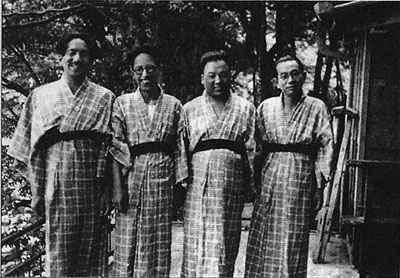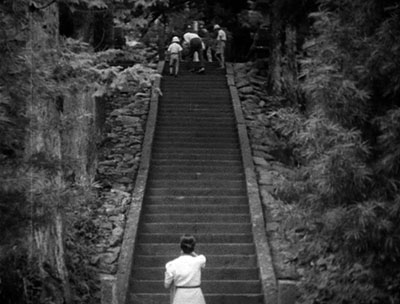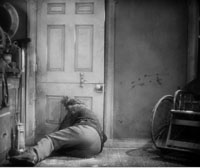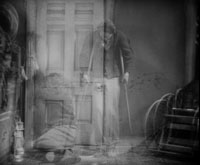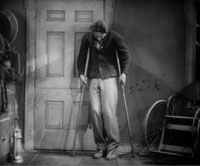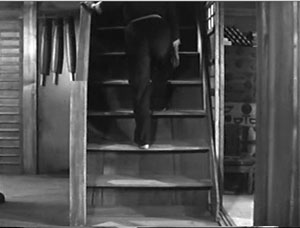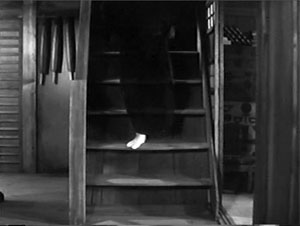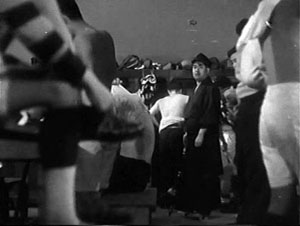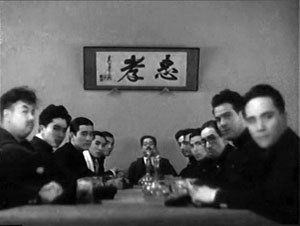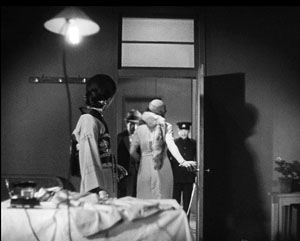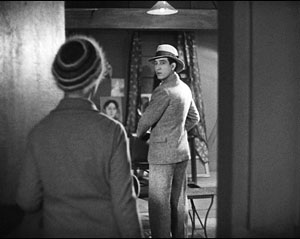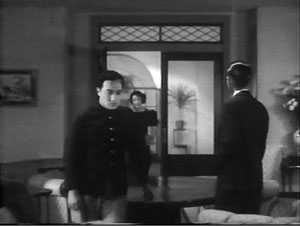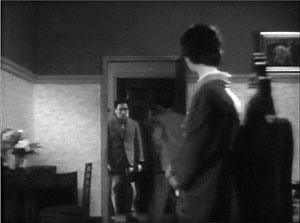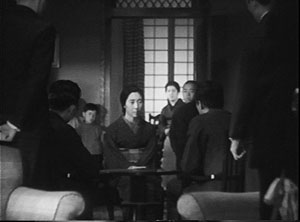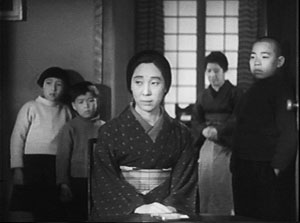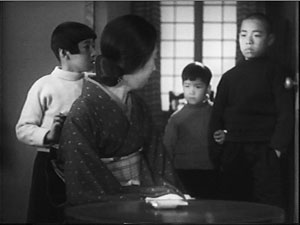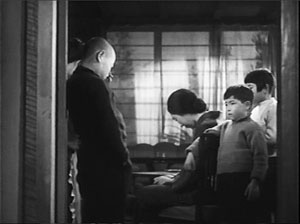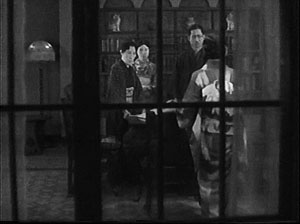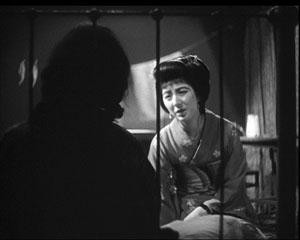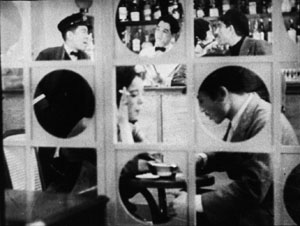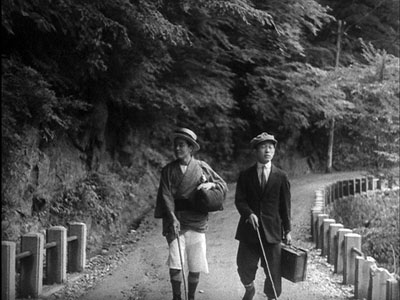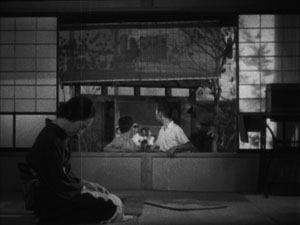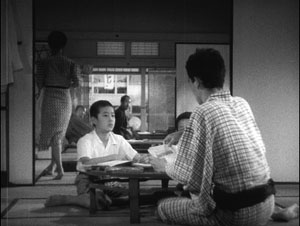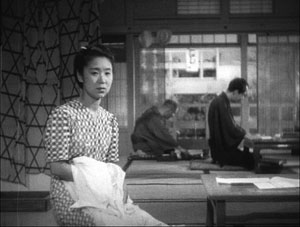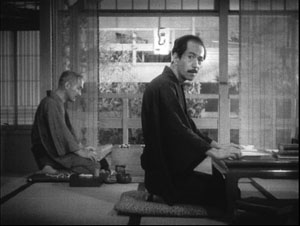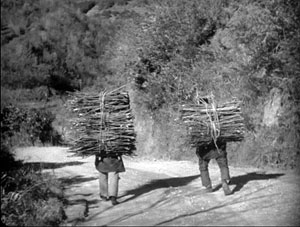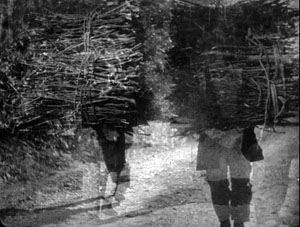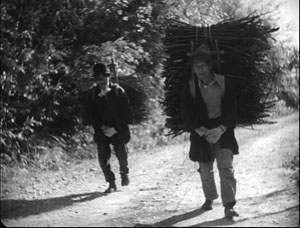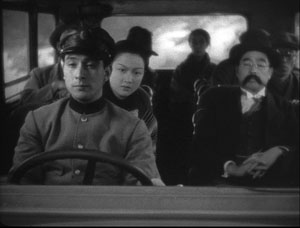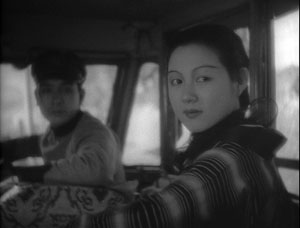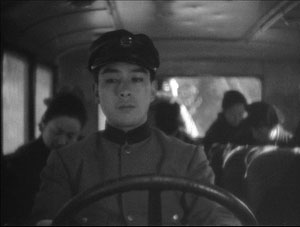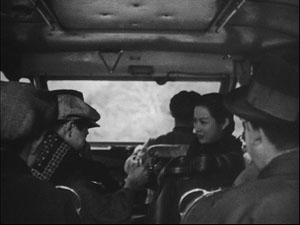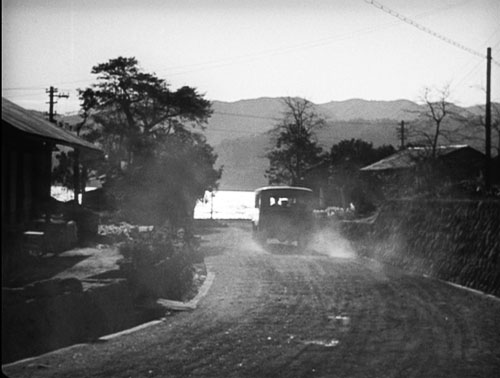Archive for the 'Directors: Shimizu Hiroshi' Category
Pierced by poetry
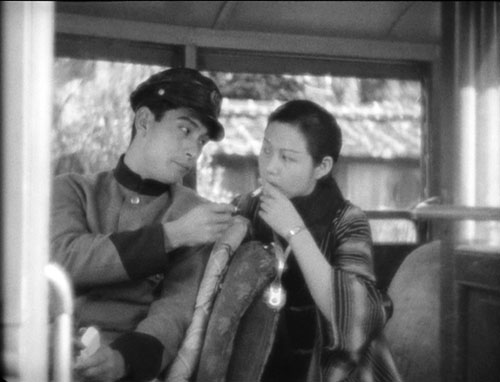
DB here:
If I had a time machine, I’d zip over to Japan between 1924 and 1940. I’d trade a year of my life here and now for a year there and then.
Why? First, because the world I see in the movies of that period holds an irresistible fascination for me. I’d like to walk through Ginza, take a train to a spa, wander through Asakusa, have tea at the Imperial Hotel, hike around the temples of Kyoto. Second, if I could go back, I could see all the films I will never see—the lost Ozus and Mizoguchis, of course, but also the films we don’t even know are important.
For Japanese cinema in the 1920s and 1930s was one of the triumphs of world cinema. That era produced not only the two directors who are arguably the very greatest but also a host of talents you can’t really call “lesser.” The bench had depth in every position.
There are good reasons for this burst of genius. Quantity affects quality, but not the way snobs think: The more movies a country makes, the more good ones you’re likely to get. Although Japan had only a little more than half the US population, before 1940 it turned out about as many features as America did.In 1936, both countries released about 530 domestic productions.
The Japanese directors who started in the 1920s had, like Ford and Walsh in their salad days, to feed this audience. We tend to forget that even exalted figures entered the industry as high-volume producers. Mizoguchi averaged about ten releases per year in his first three years, Ozu about six. Everyone’s pace slowed with the coming of sound, but the sheer volume of movies pouring from studios big and small reminds us that young directors had plenty of opportunities to hone their skills.
Probably the most startling instance is Shimizu Hiroshi. In a career that ran from 1924 to 1959, he’s credited with directing 163 films. The earliest one of his that I’ve seen is Seven Seas Part I; this 1931 feature was his seventy-fifth. “Next year,” he remarked in 1935, “I’m going to make only three films the way the company wants me to, and in exchange I can make two films that I want. I want a little more time. I’m too busy right now.” As things turned out, he signed seven films in 1936.
The great bulk of his work, 139 titles, falls before 1946. Fewer than two dozen of these seem to survive. With only about 17% of the films available, we have to keep our generalizations modest. Who knows what we would find in Love-Crazed Blade (1924) or Flaming Sky (1927) or Duck Woman (1929)? Shimizu contributed to a series, the “Boss’s Son” or “Young Master” films, of which only his first, The Boss’s Son at College (1933) seems to survive. What would we find in The Boss’s Son’s Youthful Innocence (1935) or The Boss’s Son Is a Millionaire (1936)?
Luckily, we’ve wound up with some extraordinary movies, not a clunker among the ones I’ve seen. If only a smattering of 1930s and 1940s titles is available, we should be happy that it was this smattering. Shimizu had concerns in common with Naruse Mikio and Ozu Yasujiro, but he established his own world, a rich tone, and a simple but subtle visual idiom. Along the way, he created some of the most heart-rending films in world cinema.
From the city to the spa
Shochiku talent at Izu hotspring, July 1928: Ozu Yasujiro (left), Shimizu Hiroshi (third from left), and screenwriters Fushimi Akira and Noda Kogo. Ozu and Shimizu were 23 years old.
Once more, all hail Criterion. TheTravels with Hiroshi Shimizu DVD collection released this spring includes Japanese Girls at the Harbor (1933), Mr. Thank You (1936), The Masseurs and a Woman (1938), and Ornamental Hairpin (1940). They were previously released on an expensive Japanese set (with English subtitles), but Criterion’s Eclipse series offers them at a more reasonable price, along with brief but helpful notes in English by Michael Koresky.
The collection’s title highlights the image of Shimizu that emerged in the 1980s. The films that struck Western critics then were typically shot outside the usual big cities (Tokyo, Kyoto, Osaka), in the mountains and seaside towns of the Izu peninsula. John Gillett’s 1988 National Film Theatre program, the first extensive survey of Shimizu’s work outside Japan, was entitled “Travelling Man.” Not only did Shimizu take his crew on the road, thanks to the expansion of the railway system, but he also exploited what became known as his signature technique: lengthy tracking shots down a road, following characters walking toward us.
Like Ozu, Shimizu worked in modern-day genres (gendai-geki), from slapstick comedies to college sports films. Most of what survives from before 1936 are social dramas of families, friendship, and fallen women. Seven Seas (1931-1932) deals with class conflicts, as a poor girl marries into a rich family and discovers that her husband is a bounder. Eclipse (1934) centers on the failure of young people from the countryside to succeed in a recession-hit Tokyo. The title of Hero of Tokyo (1935) is ironic, in that the stepson who abides by a mother held in disgrace by her other children, winds up destroying her last scrap of respectability. In Japanese Girls at the Harbor, two schoolgirls are driven apart by one’s passion for a young man. After a violent confrontation, she becomes a prostitute and her estranged friend winds up marrying him.
The Shochiku studio deliberately pursued a female market, and these tales of family intrigue and endlessly suffering mothers, wives, and daughters offer obvious figures of sympathy. Less predictably, the films simmer with criticism of modernizing Japan. They focus on the corruption of the upper classes, the collapse of traditions in the countryside, and the uprooting of the extended family.
Most significantly, Shimizu’s films indicate quite explicitly that Japan’s growing prosperity in the 1910s and 1920s was built on the backs of the rural poor, particularly the young women who flocked to textile mills, city shops, and brothels. Like many films of his contemporaries, Shimizu’s urban films mix sentiment and comedy with a harsh appraisal of social tendencies. I’d bet that we’d find both qualities in his Stekki garu (1929), a film apparently about the current craze for “walking stick girls,” women whom men hire to accompany them on strolls.
The manager Kido Shiro summed up the Shochiku spirit in the formula “smiles mixed with tears.” Ozu offered this blend in films like I Was Born, But… (1932) and Passing Fancy (1933), but there are precious few smiles in Shimizu’s surviving early thirties output. Then he took to the road.
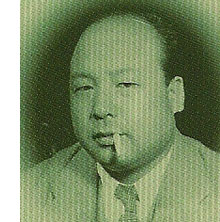 In his films of travel Shimizu still offered social criticism, but he leavened it with off-center comedy. Indeed, he intensified Kido’s mandate: In Mr. Thank You, jaunty jazz and Latin American music accompany moments of sheer pathos. Now as well Shimizu’s intricate plotting, driven by the chance meetings and startling revelations of melodrama, could relax. Films like Mr. Thank You (1936), Star Athlete (1937), and The Masseurs and a Woman (1938) are expanded anecdotes, strings of situations that accumulate in casual fashion. Dramas emerge fleetingly, on the road or in hot-springs inns. The films tend to be brief, flowing toward abrupt, muted epiphanies in the manner of a short story. These movies make you ask whether 60-75 minutes might not be the ideal length for a movie.
In his films of travel Shimizu still offered social criticism, but he leavened it with off-center comedy. Indeed, he intensified Kido’s mandate: In Mr. Thank You, jaunty jazz and Latin American music accompany moments of sheer pathos. Now as well Shimizu’s intricate plotting, driven by the chance meetings and startling revelations of melodrama, could relax. Films like Mr. Thank You (1936), Star Athlete (1937), and The Masseurs and a Woman (1938) are expanded anecdotes, strings of situations that accumulate in casual fashion. Dramas emerge fleetingly, on the road or in hot-springs inns. The films tend to be brief, flowing toward abrupt, muted epiphanies in the manner of a short story. These movies make you ask whether 60-75 minutes might not be the ideal length for a movie.
The easygoing plots echo the movies’ production process. Shimizu wasn’t an obsessive planner. Whereas Ozu sketched every shot and checked the composition through the camera, Shimizu wrote minimal screenplays and seldom budged from his chair, even when the camera was traveling. He shot quickly, making up dialogue as needed and giving actors the most cursory direction imaginable. (“Run.”) Yet this wasn’t a high-pressure situation. Some days, uncertain about what to do, Shimizu would shut down the shoot and take people swimming.
Tears and smiles
I don’t want to leave the impression that Shimizu was careless; below I’ll try to show that he set himself some powerful storytelling problems. And his relaxed manner yielded a unique mixture of traditional drama and more vagrant appeals. Take Mr. Thank You, my pick for the crown of the Criterion set.
It’s a road movie, although the trip runs only twenty miles. A rickety bus winds through the mountains around the Kawazu region of Izu, an area of hot springs and tiny villages. The handsome, kindly young driver is known only as Mr. Thank You (Arigato-san) because whenever he forces walkers off the road he waves and calls his thanks. He has earned the devotion of people in the region, who entrust him with messages and duties on their behalf. On this particular day, his bus is carrying a stuffy real-estate agent; a wisecracking moga (modern girl); and a young girl whose mother is accompanying her to Tokyo, where she is to be sold into prostitution. Other passengers—wedding guests, lonely old men—get on and off in the course of the trip.
The bus stops often, and the encounters give us vignettes of the deteriorating life of the countryside. We hear of the magic attractions of Tokyo, reported by a prosperous woman about to get married. A Korean woman working on road construction asks Mr. Thank You to visit her parents’ grave, reminding us that this oppressed minority has contributed its sweat to the new Japan. Counterbalancing these stabs of pure feeling are simple running gags, such as one involving rude auto drivers who insist on passing the bus. And across the trip, the fate of the girl draws ever closer.
The moga (evidently a hooker) becomes our raisonneur, commenting on everyone’s motives, denouncing hypocrisies, flirting with Mr. Thank You, and eventually offering advice on how to save a life. Shimizu fills his film with talk and music, but in quieter moments imagery takes over: shimmering valleys below zigzag mountain roads, tunnels and forests and glimpses of steep paths along which road workers trudge. Within the bus, point-of-view is channeled fluidly. At one point we watch the moga watching the driver watching the girl. The climax of the action is simply omitted, yielding a quick, upbeat coda. In sum, Mr. Thank You radiates the cheerful, compassionate resilience of its namesake.
The mixture of tears and smiles is present as well in The Masseurs and a Woman. In Japan, blind people traditionally have taken up the trade of massage. So we start on the road, tracking back from two masseurs feeling their way along. The gags start immediately, with one praising the view, but poignancy comes just as fast: “It’s a great feeling to pass people who can see.” And again a gag undercuts it: “I bumped into some horses and dogs, though.” Shimizu sets up his brand of incidental suspense—uncertainty about matters of no dramatic moment—when the two begin to guess how many people are advancing to them. Eight and a half? We wait and, when the shot comes, we quickly count to check.
This seesawing between humor and pathos defines the tone of the whole film. Once the men arrive at the inn, we’re introduced to several guests, and a notably piecemeal plot: an aborted romance, a mysterious theft, and the attraction of one masseur toward an enigmatic woman. On the light side, students who tease the blind get extreme massage makeovers, reducing them to hobbling the next morning in a parody of the blind men’s halting gait. Shimizu assures their humiliation by head-on shots of modern girls hiking into the midst of them. And of course the blind-guy jokes multiply when several masseurs are trying to navigate a room or a street. Again, the film is over before you know it, leaving that Shimizu tang of chance encounters and what-if possibilities.
Blind masseurs play a minor role in another spa movie, Ornamental Hairpin (1941), but an almost-begun romance is there as well. Two women, Okiku and Emi, pass through an inn, and after they’ve left Emi’s hairpin jabs a young soldier’s foot. He will spend the rest of the story recovering his ability to walk. Emi returns to the inn and joins its summer guests: a cranky professor, a grandfather and his two pesky grandsons, and a married couple.
“Pierced by poetry,” says Nanmura casually about his wound, but the professor extrapolates on the phrase, trying to weave a romantic plot out of the accident. Shimizu declines to share the fantasy. A bit like Tati’s M. Hulot’s Holiday, the film is threaded with mundane vacation routines that become running gags, overwhelming what we expect to shape up as a courtship.
Bronzing in the sun and helping Nanmura recover his ability to walk, Emi comes to believe that she has found happiness. She has fled Tokyo and wants to start fresh. But her past, either as wife or kept woman, is kept vague. In two remarkable scenes, one a phone conversation and the other a dialogue with Okiku, her situation is sketched. We start to fear that her man will even come looking for her.
But these bits of conventional plotting are drop away among prolonged scenes of spa gossip and lazy pastimes. The most suspenseful sequences are devoted to Nanmura’s gradual recovery—a sort of deadline, since when he walks again, he will leave. If ever a climax refused to arrive, it’s during the last ten minutes or so of Ornamental Hairpin. The moments of pathos or conflict we would ordinarily see are skipped over, and the surroundings of “minor” scenes become infused with regret.
Shimizu’s ramblings through Izu didn’t lead him to abandon his probing of urban anomie, as we can see in Forget Love for Now (1937). (This must be one of the great Anglicized Japanese titles. I rank it with Blackmail Is My Life and Go, Go, Second-Time Virgin.) And at the same time he consolidated that talent for which he was best known in his lifetime: the exploration of childhood. Children in the Wind (1937), Four Seasons of Children (1939), and Introspection Tower (1941) offer unsentimental portrayal of boys’ rituals and their tenacity in the face of hardship. Shimizu founded an orphanage after the war, and he employed some of his charges in postwar films like Children of the Beehive (1948). Shochiku’s second boxed set, also with English subtitles, gives us the first three I’ve mentioned, plus the schoolteacher drama Nobuko (1940).
East meets West, and North meets South
Ornamental Hairpin.
Japanese film studios differed from their American counterparts in encouraging directors to cultivate individual styles. Kido supposedly fired Naruse by saying, “We don’t need two Ozus.” While Shimizu is not as daring or meticulous a stylist as Ozu, he managed to cultivate a visual approach that, however straightforward, was capable of delicate refinements.
In general, the Shimizus we have conform to trends in Japanese films of his period. His silent films from the years 1931-1935 adhere broadly to the Shochiku house style, using plenty of cuts and single framings of individuals. Most of the surviving silents have average shot lengths between 5 and 6 seconds, completely normal for both Japanese and US silent movies.
More remarkable is the number of dialogue titles, which make up between 24% and 44% of all shots. This would be exceptional for an American film of the 1920s. Other Japanese films, particularly Mizoguchi’s, are heavy with intertitles, but Shimizu took the trend somewhat farther. The preponderance of dialogue titles may owe something to the presence of both American and a few Japanese talking pictures at the time, which justified more spoken lines. In addition, at this period the influence of the benshi, the vocal accompanist to silent films, was waning, and the movies were becoming more self-sufficient in their narration. The hundreds of titles flashing by in Shimizu’s films would specify the scene’s action and curb the benshi’s urge to improvise.
Shimizu’s silent films that survive also contain several instances of a technique I’ve called the “dissolve in place.” The camera setup remains fixed, but one or more dissolves convey the changes in the space across a period of time. It’s commonly used to show long periods; in A Hero of Tokyo, the family’s growing poverty is shown through dissolves that gradually remove the furniture they’re been forced to sell. The technique can be seen in American silent films, a major source for most Japanese directors. Here’s a lovely example from Frank Borzage’s Lucky Star (1929), as the partly paralyzed Tim struggles to climb onto his crutches.
Shimizu often goes a little further by matching the figures precisely across a dissolve. In The Boss’s Son at College, the hero comes home but then sneaks out in his bare feet, and the dissolves concentrate on the reversal of movement, first upstairs, then down.
Again, this device was used by other Japanese directors, even Ozu in some early works, but Shimizu seems to have clung to it longer than most.
In general, Shimizu’s silent films don’t borrow his pal Ozu’s more idiosyncratic techniques. Shimizu doesn’t employ intermediate spaces to link scenes, or create elaborately disruptive transitions, or embed characters in 360-degree shooting space. Sometimes he offers mismatched eyelines in reverse shots, but these don’t usually cultivate the graphically exact alignment we find in Ozu’s editing. Still, Shimizu does often construct a scene’s space in a distinctive way.
For one thing, he will stage many scenes in long shot or even extreme long shot. Within that sort of shot, he’s often drawn to deep perspective, often with a central vanishing point. This is most apparent as a visual motif throughout The Boss’s Son at College.
More interestingly, his fascination with perpendicular depth governs staging and cutting. Imagine a line stretched straight out from the camera lens. By 1935 this lens axis has become Shimizu’s lifeline, his equivalent of the surveyor’s level. Rather than filling the foreground with a big figure or a face or prop, and rather than spreading his depth items wide across the background, he will pack the most important people along the center axis, like crystals growing out from a string. Here are instances from Japanese Girls at the Harbor and Eclipse.
Shimizu’s co-workers have testified that he cared little for the 180-degree rule. Like many Japanese filmmakers, he played fast and loose with it. Instead of an axis running between the characters, he was more concerned with the axis of the lens itself. He often respects that by cutting from one shot to a point (along the axis) 180 degrees opposite.
He also respects the lens axis by cutting straight in and out. In Hero of Tokyo, the mother learns that her husband has pulled a swindle and fled; then the officials leave her alone with her children. Shimizu simply enlarges and shrinks her systematically along the axis. He takes us to the other side of the group for the climax, when her birth children pull away from her stepson. We see no other camera positions in the scene.
This patterning is less abrasive than it might appear because intertitles are sandwiched in among these shots. It’s an intriguing strategy for thrifty filmmaking, since it requires only a rudimentary set, but it also offers a simple way to inflect the drama. Similar axial cuts, though not cushioned by titles, can be found in the shooting scene of Japanese Girls at the Harbor (which may owe something to French and Soviet cutting experiments of the period).
The depth stretching out from the camera lens is crosscut by another plane, perpendicular to it. This plane is often a patterned surface—windows, grillwork, a bedstead. Again, instead of Mizoguchi’s or Ozu’s angular foregrounds, we have an east-west axis slicing through the shot. The frames become boxes, and the characters play out their dramas within the cells of a grid, as in Seven Seas Part II and Japanese Girls at the Port.
Here again, Shimizu is relying on a device that other directors were using at the time. Many compositions of the 1930s play peekaboo with characters and setting. Here’s a flamboyant example from First Steps Ashore (Shimazu Yasujiro, 1932).
So instead of defining space through exaggerated foregrounds, plunging diagonals, or curvilinear edges, Shimizu goes Cartesian on us. His most distinctive layouts rely on two dimensions, one running straight into depth, the other running left to right. The result is a discreet, foursquare style well-suited to concise storytelling (and presumably, to turning out films quickly). Shimizu’s peers indulged in flashier shots, but his persistent choices yield a quiet variant of that continuity system that was already the lingua franca of world cinema.
Hitting the road
What about the sound films? Many Shimizu films still rely on distant planes of depth, as in this shot from Children of the Wind, when, after the father’s arrest, the boys’ buddies arrive at a far-off vantage point.
Interiors will sometimes be given the axial-cutting treatment, as in this passage from Ornamental Hairpin.
And now the crosscut horizontal plane often gets actualized as rooms gliding by the lens in lateral tracking shots. But in general, interior scenes in this 1941 film aren’t as strictly organized as in the silent films. This corresponds to a general move toward more orthodox technique in Japanese films of the period.
Something more original happens in the outdoor traveling shots. Now Shimizu’s beloved camera axis finds tangible expression in the highway. His much-vaunted tracking shots up and down the road translate the silent films’ axial depth into forward and backward movement, and characters, again organized in relation to the axis, are presented with a new simplicity and directness. Rather than being a one-off device, the road shots seem to be a development of the Cartesian coordinates that Shimizu has experimented with in the interior spaces of his silent films.
Star Athlete offers some remarkable examples of the push-pull effects built around the axis—tracking back from advancing characters, or tracking toward retreating ones. But Shimizu’s most thoroughgoing exploration of the camera axis in transit takes place in Mr. Thank You. The first thirteen shots lay out a stylistic matrix, with variants dropped in to prepare us for more compact expression later.
Shot 1: A long shot of the bus approaching.
Shots 2-4: We get the bus’s point of view of the road, with road workers in view; head-on shot of the driver calling “Thank you!” as the men step back; and the bus’s pov of the road receding, with the workers resuming. Dissolve to:
Shots 5-7: Bus’s pov of horsecart ahead; reverse angle of driver calling, “Thank you!”; bus’s pov of cart receding. Dissolve to:
Shots 8-9: Bus’s pov of men toting wood; we hear, “Thank you!” as we dissolve to bus’s pov of men receding. Dissolve to:
Shots 10-11: Bus’s pov of women carrying bundles; we hear, “Thank you!” as we dissolve to bus’s pov of women receding. Dissolve to:
Shot 12: Bus’s pov of chickens in road. They scatter as we get closer.
Shot 13: Long shot of bus going into the distance as we hear, “Thank you!”
The cycles move from three-shot clusters to two-shot clusters to a single shot, and a gag at that. (This driver even thanks poultry for traffic courtesy.) As another touch, Shimizu’s prized dissolves-in-place are recalled when the pedestrians approached from the back transform themselves into figures dwindling into the distance.
The same insistence on rectilinear framing takes place on the bus. Using 180-degree reversals, Shimizu creates a remarkable variety of shot scales in the cramped space of a real vehicle, always obeying his self-imposed geometry–facing either forward or backward.
As the trip gains emotional intensity, Shimizu will vary his treatment of these principles. For example, the middle section’s emphasis on forward movement will be counterbalanced near the end by a string of shots of passengers already off the bus, passing into the distance as we roll away.
In Shimizu, compact storytelling is matched by a pictorial strictness that doesn’t seem forced or stiff. After all, people do tend to line up to face one another in depth, and roads and buses do seem to run in two directions. Poetry in language demands strictures of meter, rhythm, rime, and the like, for these can pressurize expressive energies. Shimizu’s films present a disciplined lyricism: powerfully oblique emotions are shaped by simple but rich techniques of storytelling and style.
Most of my information about Shimizu’s work habits comes from essays and interviews in Shimizu Hiroshi: 101st Anniversary, ed. Li Cheuk-to (Hong Kong: Hong Kong International Film Festival, 2004). For more on Shimizu’s surviving silent films, see William Drew’s penetrating essay in Midnight Eye. Alexander Jacoby offers a sympathetic career overview atSenses of Cinema. For a filmography, see Jacoby’s A Critical Handbook of Japanese Film Directors: From the Silent Era to the Present Day Stone Bridge, 2008). Isolde Standish reviews Shochiku’s studio policies in Chapter 1 of her A New History of Japanese Cinema: A Century of Narrative Film (Continuum, 2005).
Noël Burch was one of the first Western writers to appreciate Shimizu’s artistry. His indispensible 1979 book To the Distant Observer: Form and Meaning in the Japanese Cinema is available in its entirety here. The Shimizu chapter, concentrating mainly on Star Athlete, starts here. I offer discussions of stylistic trends in Japanese cinema in Ozu and the Poetics of Cinema (Princeton University Press, 1988), available in toto here, and in two essays in Poetics of Cinema (Routledge, 2008), 337-395.
You can find passionate conversations about Shimizu and the release of these DVDs at the Criterion Forum. See especially the comments of Michael Kerpan.












